2005 NISSAN NAVARA body
[x] Cancel search: bodyPage 1697 of 3171
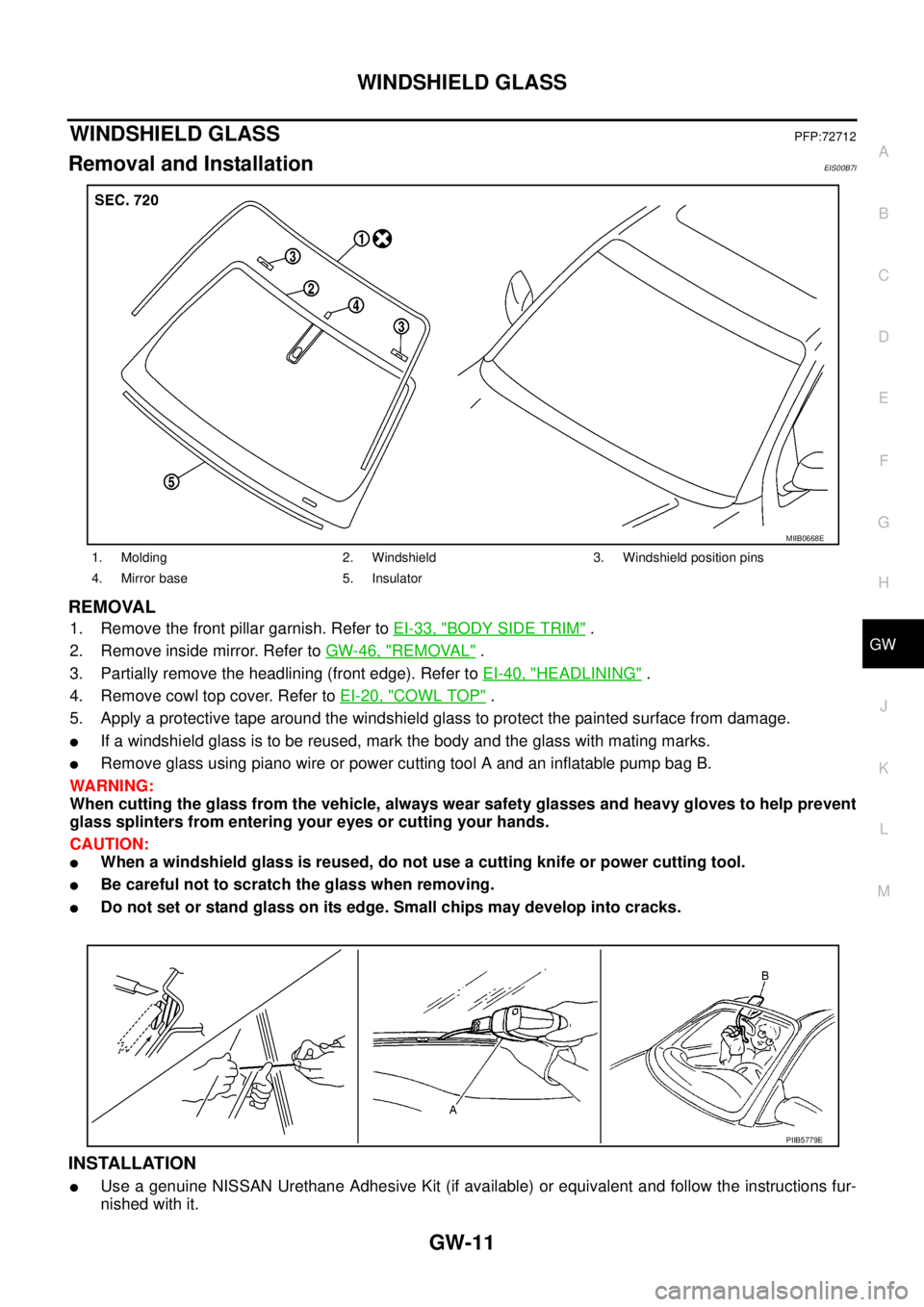
WINDSHIELD GLASS
GW-11
C
D
E
F
G
H
J
K
L
MA
B
GW
WINDSHIELD GLASSPFP:72712
Removal and InstallationEIS00B7I
REMOVAL
1. Remove the front pillar garnish. Refer toEI-33, "BODY SIDE TRIM".
2. Remove inside mirror. Refer toGW-46, "
REMOVAL".
3. Partially remove the headlining (front edge). Refer toEI-40, "
HEADLINING".
4. Remove cowl top cover. Refer toEI-20, "
COWL TOP".
5. Apply a protective tape around the windshield glass to protect the painted surface from damage.
lIf a windshield glass is to be reused, mark the body and the glass with mating marks.
lRemove glass using piano wire or power cutting tool A and an inflatable pump bag B.
WARNING:
When cutting the glass from the vehicle, always wear safety glasses and heavy gloves to help prevent
glass splinters from entering your eyes or cutting your hands.
CAUTION:
lWhen a windshield glass is reused, do not use a cutting knife or power cutting tool.
lBe careful not to scratch the glass when removing.
lDo not set or stand glass on its edge. Small chips may develop into cracks.
INSTALLATION
lUse a genuine NISSAN Urethane Adhesive Kit (if available) or equivalent and follow the instructions fur-
nished with it.
1. Molding 2. Windshield 3. Windshield position pins
4. Mirror base 5. Insulator
MIIB0668E
PIIB5779E
Page 1700 of 3171

GW-14
WINDSHIELD GLASS
Repairing Water Leaks for Windshield
Leaks can be repaired without removing and reinstalling glass.
If water is leaking between the urethane adhesive material and body or glass, determine the extent of leakage.
This can be done by applying water to the windshield area while pushing glass outward.
To stop the leak, apply primer (if necessary) and then urethane adhesive to the leak point.
7. Cowl top panel 8. Insulator 9. Instrument panel
10. Cowl top cover
Page 1702 of 3171

GW-16
POWER WINDOW SYSTEM
lthrough BCM terminal 53
lto power window main switch terminal 2
lto ftont power window switch (passenger side) terminal 1
lto rear power window switches LH and RH terminal 1 (with rear power window).
Ground is supplied
lto BCM terminal 55
lto front power window motor and control unit terminal 3
lto power window main switch terminal 3
lthrough body grounds M21, M80 and M83.
MANUAL OPERATION
Front Driver Side Door
WINDOW UP
When the driver side switch in the power window main switch is pressed in the up position,
Ground is supplied
lto front power window motor and control unit terminal 2
lthrough power window main switch terminal 4
lthrough power window main switch terminal 3
Then, the motor raises the window until the switch is released.
WINDOW DOWN
When the driver side switch in the power window main switch is pressed in the down position
Ground is supplied
lto front power window motor and control unit terminal 1
lthrough power window main switch terminal 5
lthrough power window main switch terminal 3
Then, the motor lowers the window until the switch is released.
Front Passenger Side Door
FRONT POWER WINDOW SWITCH (PASSENGER SIDE) OPERATION
WINDOW UP
When the front power window switch (passenger side) is operated in the up position
Power is supplied
lthrough front power window switch (passenger side) terminal 1 and 5
lto front power window motor (passenger side) terminal 2.
Ground is supplied
lto front power window motor (passenger side) terminal 1
lthrough front power window switch (passenger side) terminal 4 and 3
lthrough power window main switch terminal 7
Then, the motor raises the window until the switch is released.
WINDOW DOWN
When the front power window switch (passenger side) is opeataed in the down position
Power is supplied
lthrough front power window switch (passenger side) terminal 1 and 4
lto front power window motor (passenger side) terminal 1.
Ground is supplied
lto front power window motor (passenger side) terminal 2
lthrough front power window switch (passenger side) terminal 5 and 2
lthrough power window main switch terminal 6
Then, the motor lowers the window until the switch is released.
POWER WINDOW MAIN SWITCH OPERATION
WINDOW UP
When the passenger side switch in power window main switch is operated in the up position
Power is supplied
Page 1728 of 3171
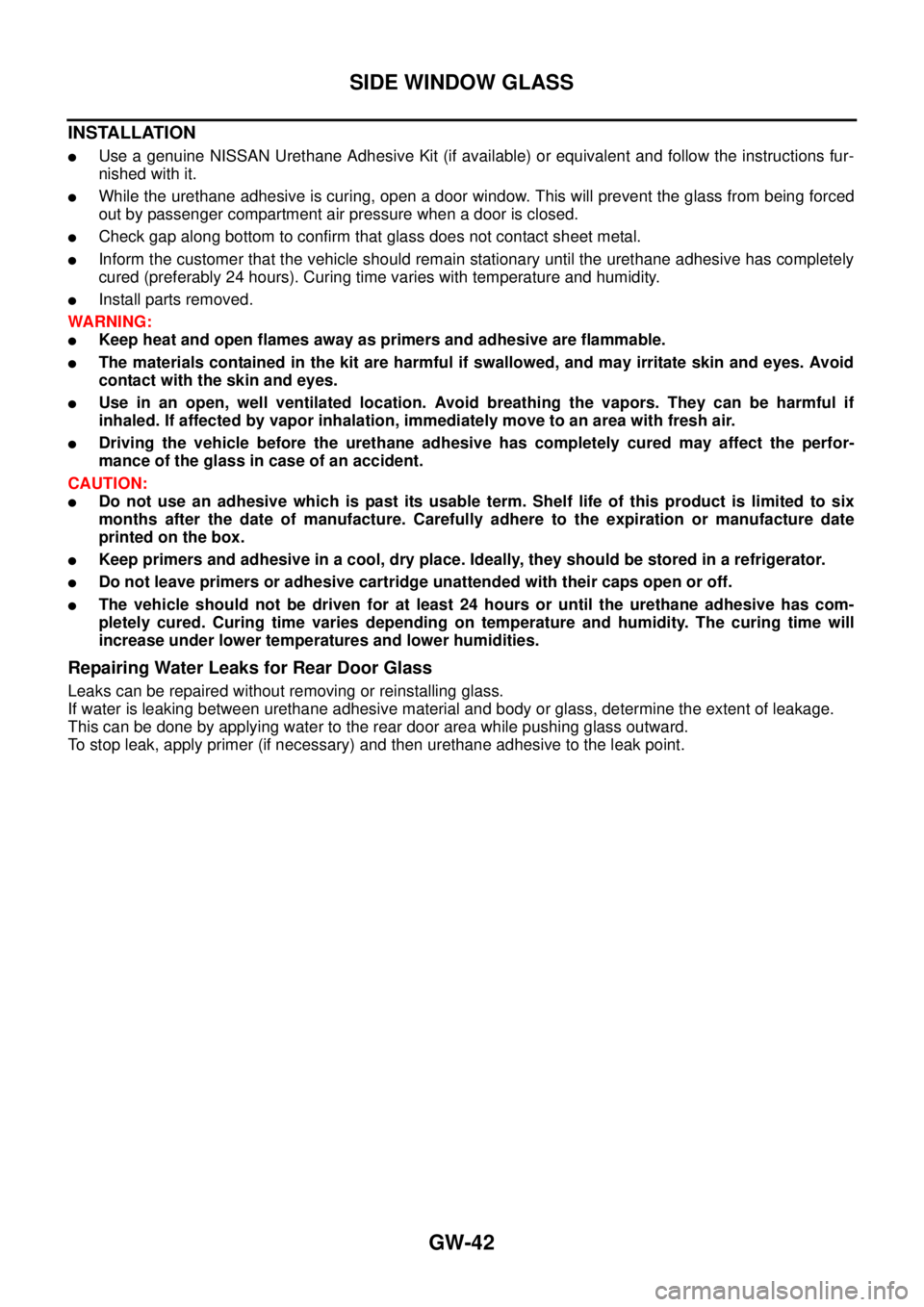
GW-42
SIDE WINDOW GLASS
INSTALLATION
lUse a genuine NISSAN Urethane Adhesive Kit (if available) or equivalent and follow the instructions fur-
nished with it.
lWhile the urethane adhesive is curing, open a door window. This will prevent the glass from being forced
out by passenger compartment air pressure when a door is closed.
lCheck gap along bottom to confirm that glass does not contact sheet metal.
lInform the customer that the vehicle should remain stationary until the urethane adhesive has completely
cured (preferably 24 hours). Curing time varies with temperature and humidity.
lInstall parts removed.
WARNING:
lKeep heat and open flames away as primers and adhesive are flammable.
lThe materials contained in the kit are harmful if swallowed, and may irritate skin and eyes. Avoid
contact with the skin and eyes.
lUse in an open, well ventilated location. Avoid breathing the vapors. They can be harmful if
inhaled. If affected by vapor inhalation, immediately move to an area with fresh air.
lDriving the vehicle before the urethane adhesive has completely cured may affect the perfor-
mance of the glass in case of an accident.
CAUTION:
lDo not use an adhesive which is past its usable term. Shelf life of this product is limited to six
months after the date of manufacture. Carefully adhere to the expiration or manufacture date
printed on the box.
lKeep primers and adhesive in a cool, dry place. Ideally, they should be stored in a refrigerator.
lDo not leave primers or adhesive cartridge unattended with their caps open or off.
lThe vehicle should not be driven for at least 24 hours or until the urethane adhesive has com-
pletely cured. Curing time varies depending on temperature and humidity. The curing time will
increase under lower temperatures and lower humidities.
Repairing Water Leaks for Rear Door Glass
Leaks can be repaired without removing or reinstalling glass.
If water is leaking between urethane adhesive material and body or glass, determine the extent of leakage.
This can be done by applying water to the rear door area while pushing glass outward.
To stop leak, apply primer (if necessary) and then urethane adhesive to the leak point.
Page 1729 of 3171
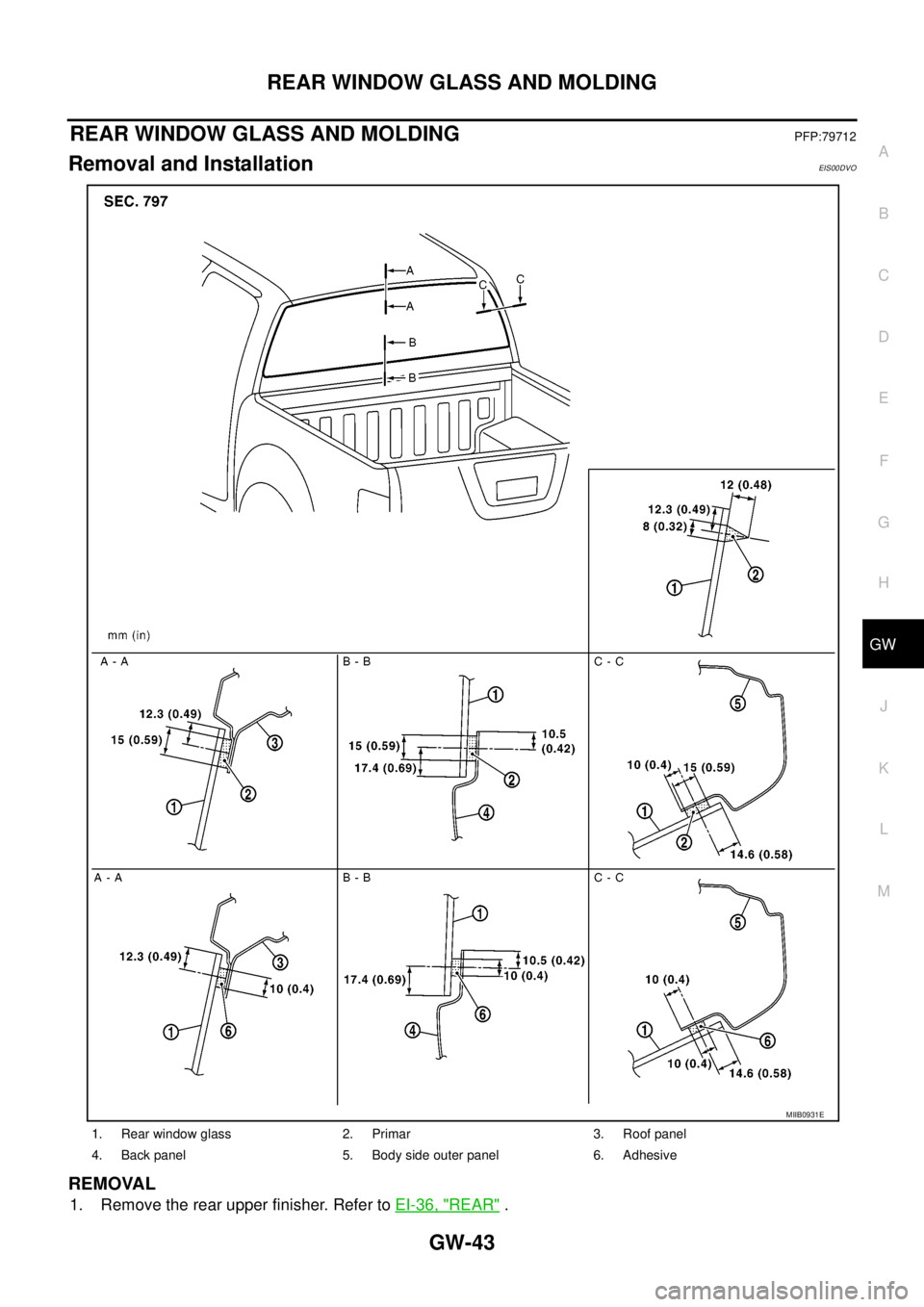
REAR WINDOW GLASS AND MOLDING
GW-43
C
D
E
F
G
H
J
K
L
MA
B
GW
REAR WINDOW GLASS AND MOLDINGPFP:79712
Removal and InstallationEIS00DVO
REMOVAL
1. Remove the rear upper finisher. Refer toEI-36, "REAR".
1. Rear window glass 2. Primar 3. Roof panel
4. Back panel 5. Body side outer panel 6. Adhesive
MIIB0931E
Page 1730 of 3171
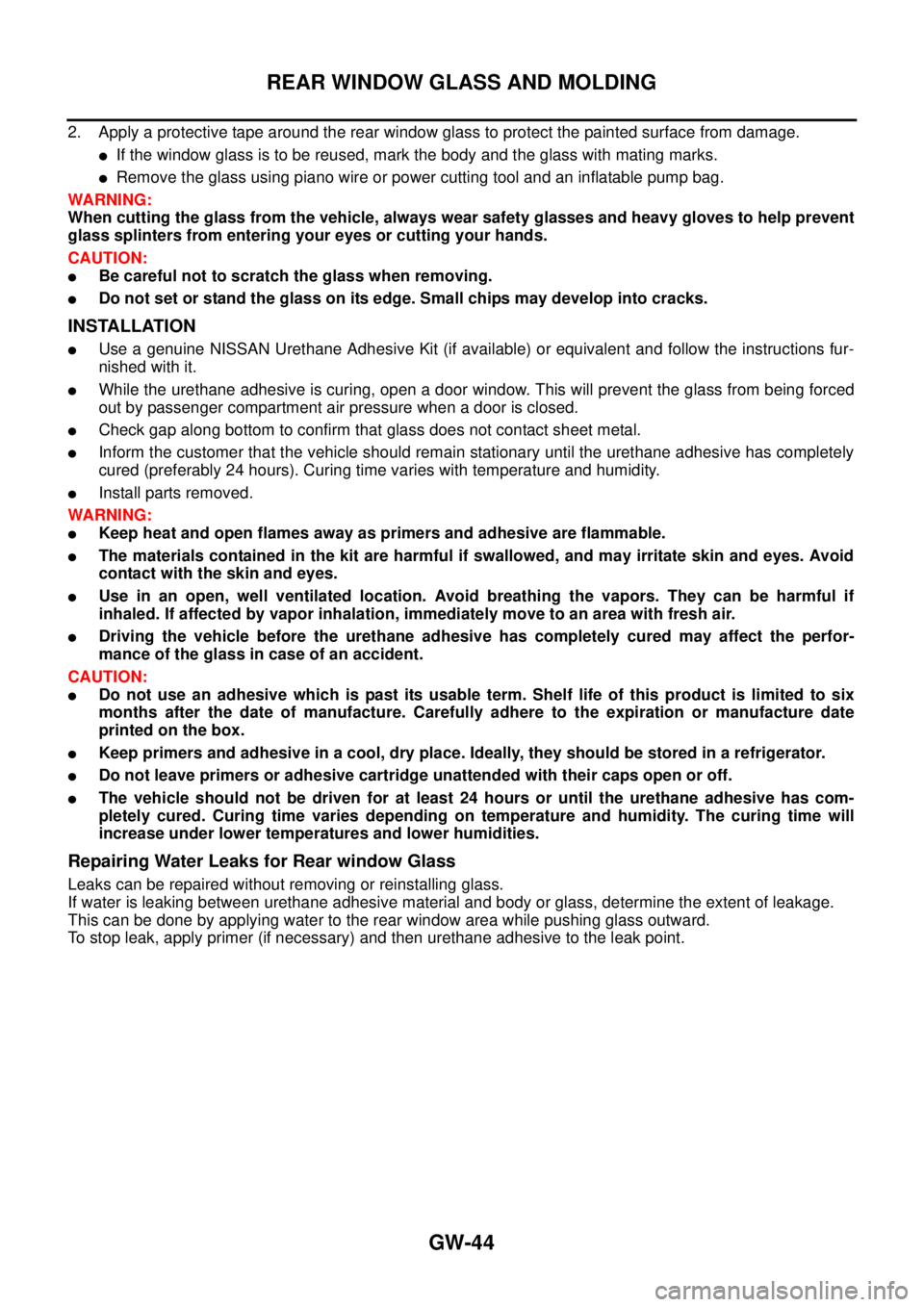
GW-44
REAR WINDOW GLASS AND MOLDING
2. Apply a protective tape around the rear window glass to protect the painted surface from damage.
lIf the window glass is to be reused, mark the body and the glass with mating marks.
lRemove the glass using piano wire or power cutting tool and an inflatable pump bag.
WARNING:
When cutting the glass from the vehicle, always wear safety glasses and heavy gloves to help prevent
glass splinters from entering your eyes or cutting your hands.
CAUTION:
lBe careful not to scratch the glass when removing.
lDo not set or stand the glass on its edge. Small chips may develop into cracks.
INSTALLATION
lUse a genuine NISSAN Urethane Adhesive Kit (if available) or equivalent and follow the instructions fur-
nished with it.
lWhile the urethane adhesive is curing, open a door window. This will prevent the glass from being forced
out by passenger compartment air pressure when a door is closed.
lCheck gap along bottom to confirm that glass does not contact sheet metal.
lInform the customer that the vehicle should remain stationary until the urethane adhesive has completely
cured (preferably 24 hours). Curing time varies with temperature and humidity.
lInstall parts removed.
WARNING:
lKeep heat and open flames away as primers and adhesive are flammable.
lThe materials contained in the kit are harmful if swallowed, and may irritate skin and eyes. Avoid
contact with the skin and eyes.
lUse in an open, well ventilated location. Avoid breathing the vapors. They can be harmful if
inhaled. If affected by vapor inhalation, immediately move to an area with fresh air.
lDriving the vehicle before the urethane adhesive has completely cured may affect the perfor-
mance of the glass in case of an accident.
CAUTION:
lDo not use an adhesive which is past its usable term. Shelf life of this product is limited to six
months after the date of manufacture. Carefully adhere to the expiration or manufacture date
printed on the box.
lKeep primers and adhesive in a cool, dry place. Ideally, they should be stored in a refrigerator.
lDo not leave primers or adhesive cartridge unattended with their caps open or off.
lThe vehicle should not be driven for at least 24 hours or until the urethane adhesive has com-
pletely cured. Curing time varies depending on temperature and humidity. The curing time will
increase under lower temperatures and lower humidities.
Repairing Water Leaks for Rear window Glass
Leaks can be repaired without removing or reinstalling glass.
If water is leaking between urethane adhesive material and body or glass, determine the extent of leakage.
This can be done by applying water to the rear window area while pushing glass outward.
To stop leak, apply primer (if necessary) and then urethane adhesive to the leak point.
Page 1734 of 3171
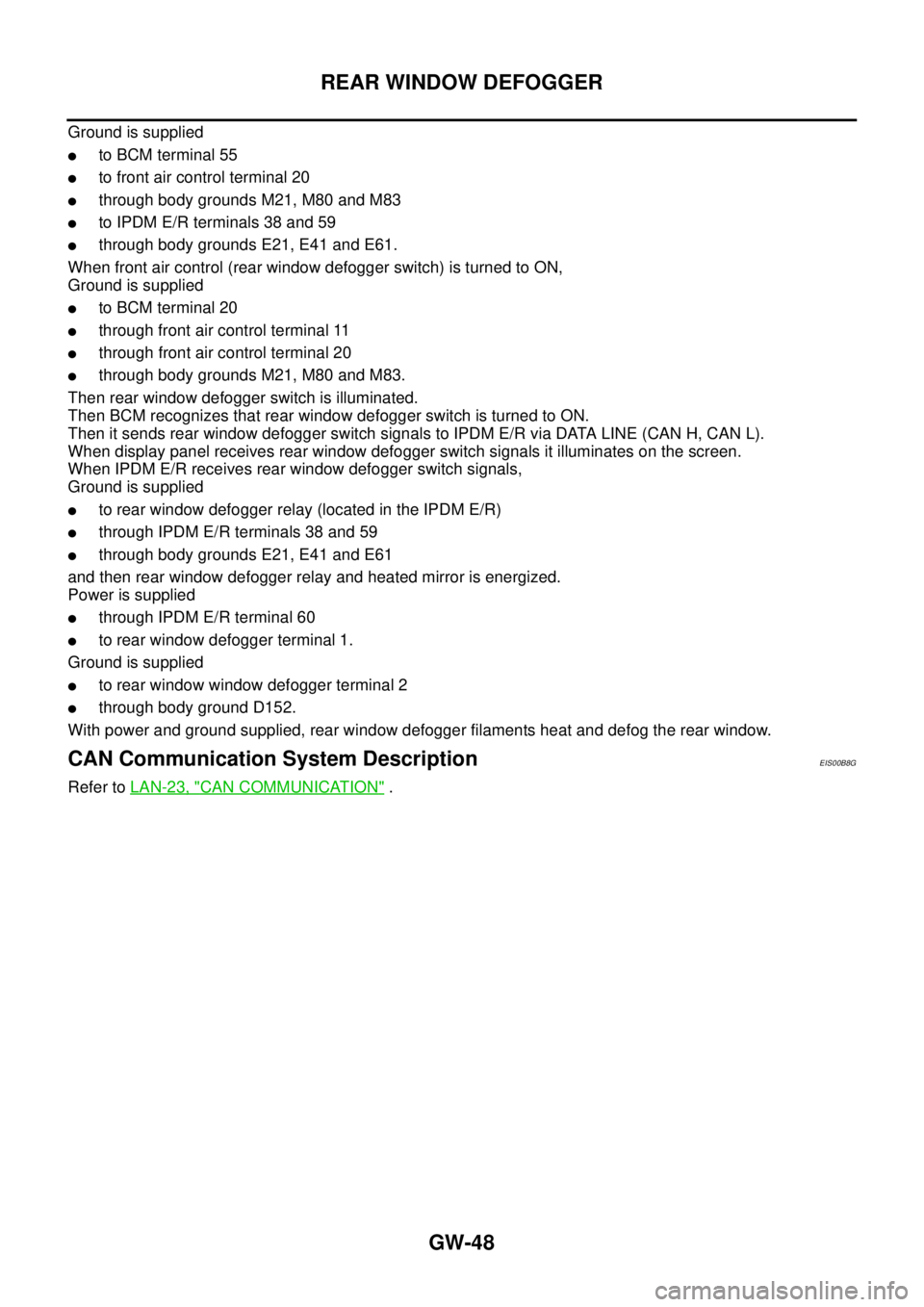
GW-48
REAR WINDOW DEFOGGER
Ground is supplied
lto BCM terminal 55
lto front air control terminal 20
lthrough body grounds M21, M80 and M83
lto IPDM E/R terminals 38 and 59
lthrough body grounds E21, E41 and E61.
When front air control (rear window defogger switch) is turned to ON,
Ground is supplied
lto BCM terminal 20
lthrough front air control terminal 11
lthrough front air control terminal 20
lthrough body grounds M21, M80 and M83.
Then rear window defogger switch is illuminated.
Then BCM recognizes that rear window defogger switch is turned to ON.
Then it sends rear window defogger switch signals to IPDM E/R via DATA LINE (CAN H, CAN L).
When display panel receives rear window defogger switch signals it illuminates on the screen.
When IPDM E/R receives rear window defogger switch signals,
Ground is supplied
lto rear window defogger relay (located in the IPDM E/R)
lthrough IPDM E/R terminals 38 and 59
lthrough body grounds E21, E41 and E61
and then rear window defogger relay and heated mirror is energized.
Power is supplied
lthrough IPDM E/R terminal 60
lto rear window defogger terminal 1.
Ground is supplied
lto rear window window defogger terminal 2
lthrough body ground D152.
With power and ground supplied, rear window defogger filaments heat and defog the rear window.
CAN Communication System DescriptionEIS00B8G
Refer toLAN-23, "CAN COMMUNICATION".
Page 1751 of 3171
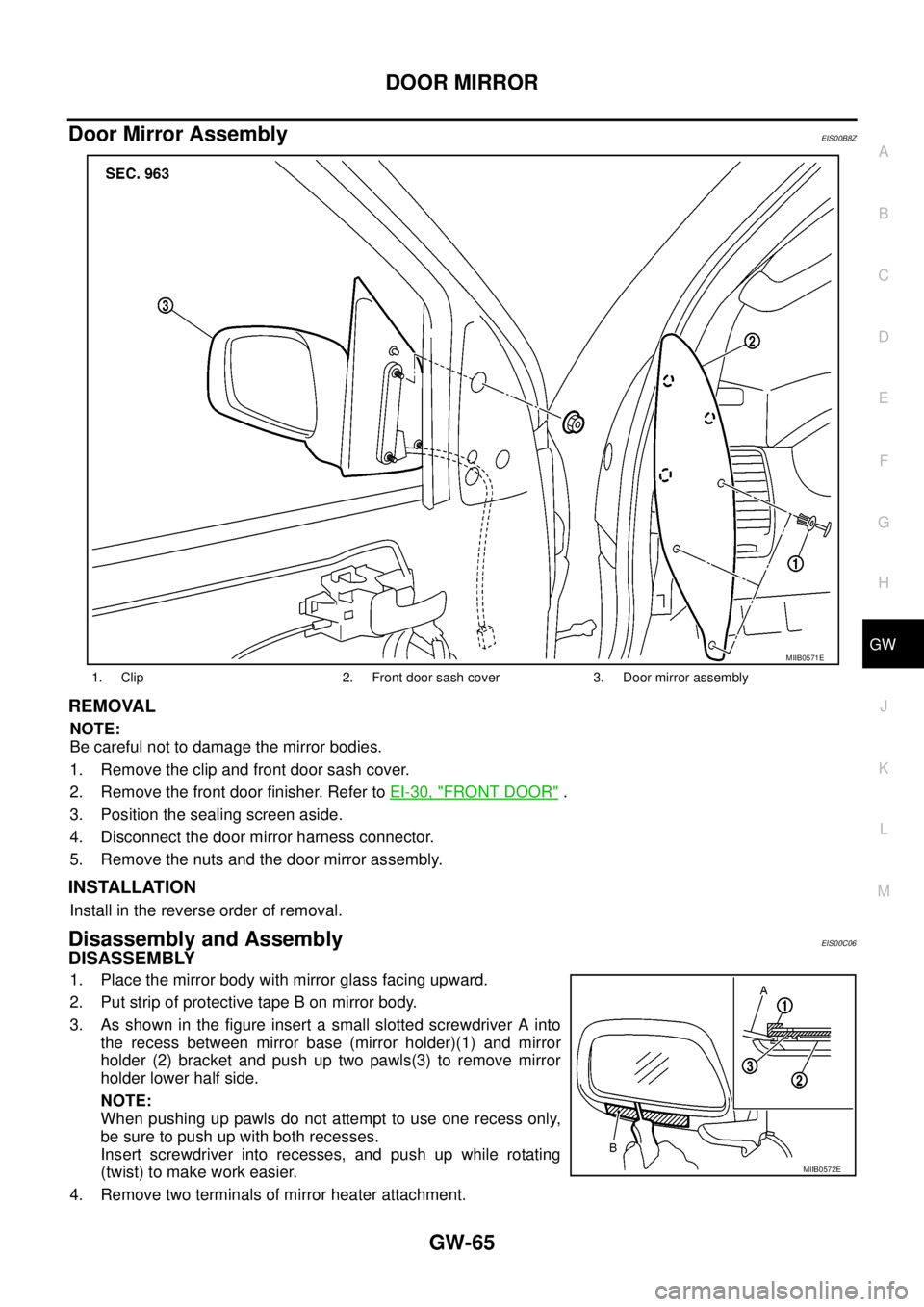
DOOR MIRROR
GW-65
C
D
E
F
G
H
J
K
L
MA
B
GW
Door Mirror AssemblyEIS00B8Z
REMOVAL
NOTE:
Be careful not to damage the mirror bodies.
1. Remove the clip and front door sash cover.
2. Remove the front door finisher. Refer toEI-30, "
FRONT DOOR".
3. Position the sealing screen aside.
4. Disconnect the door mirror harness connector.
5. Remove the nuts and the door mirror assembly.
INSTALLATION
Install in the reverse order of removal.
Disassembly and AssemblyEIS00C06
DISASSEMBLY
1. Place the mirror body with mirror glass facing upward.
2. Put strip of protective tape B on mirror body.
3. As shown in the figure insert a small slotted screwdriver A into
the recess between mirror base (mirror holder)(1) and mirror
holder (2) bracket and push up two pawls(3) to remove mirror
holder lower half side.
NOTE:
When pushing up pawls do not attempt to use one recess only,
be sure to push up with both recesses.
Insert screwdriver into recesses, and push up while rotating
(twist) to make work easier.
4. Remove two terminals of mirror heater attachment.
1. Clip 2. Front door sash cover 3. Door mirror assembly
MIIB0571E
MIIB0572E